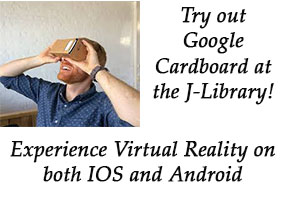Welcome to the world of Virtual Reality
Your Cardboard viewer is a medium like we have never seen before
By Clyde Bentley, Associate Professor
The Google Cardboard is one of the recent wave of devices that allows the viewer to experience a scene almost like being there. It was developed about the same time as the Oculus Rift, for which Facebook paid $2 billion. A pair of Google engineers, however, wanted to see how inexpensively they could make an Oculus-type viewer. They put two cheap plastic lenses into a folded box and powered it with a mobile phone. Google opened the design to the public, allowing anyone to manufacture it. You can go online and get instructions to cut one out of a pizza box, buy a fold-out version $15 or pay much more for a plastic or metal version with quality optics.
Here is a quick guide to exploring the Cardboard:
The door at the back of the Cardboard opens to accept your phone. Some programs make you place it in a certain direction, but most don’t care. Experiment.
On the Version 1 Cardboards, you could slide a ring magnet on the right side to “click” or change pages. It really only worked well on Android phones, though, so Version 2 has a paper button coated with the conductive material you often see on glove fingers. All it is really doing is touching the screen, which you can also do with your own finger.
First, install the official Cardboard App on your iOS or Android phone. You don’t need it to use a Cardboard, but it is a good base for checking out the technology. It has a number of awe-inspiring still scenes – my favorite is the Eiffel Tower. The app uses the “old” way of navigating – change pages by tipping the Cardboard on its side.
The key to using the Cardboard is to move your body. Crank your head up to see the top of the Eiffel tower, down to see the pigeons on the sidewalk or turn around to see the street vendors. Don’t just shift your eyes – move.
There are more than 100 apps using Cardboard, dozens of websites and a whole section of YouTube. Some require you to download the file, others stream it. Search for “Google Cardboard” to find the latest, but here are a few worth trying.
- Jaunt VR is a site used by some news organizations. Check Inside Syria, a compelling report done by ABC. There are also a lot of good music videos.
- Vrse is the original Cardboard documentary film site. Long pieces worth watching
- VR Stories also has news pieces, including one on the Selma march.
- RYOT is better, though. Especially Welcome to Aleppo.YouVisit takes you on tours of universities and citiesBut let’s have fun.
- Skydive 360 puts you in the air, then drops you. You can turn and see the plane fade away or turn and see the ground getting closer by the second. Keep Tums handy.
- 360Heros is by GoPro, so it’s full of crazy skiing, kayaking and testosterone thrills. I rather like the bulls running at Pamplona (San Fermin 2015). It is probably the only way to be right in the herd without being trampled or gored.
- MUST HAVE – in360Tube, the YouTube app for Cardboard. It has a terrible navigation system, but offers lots of videos. It is probably best to Search YouTube 360 on a computer, find the videos you want and make a playlist that you can email to your phone. Here are some good ones, however:CAUGHT ON 360 CAM!! Low quality, but a real hoot and a good introduction to what you can do with 360-degree video. It’s by blogger Roman Atwood.
o Hajj 360 – experience the journey to Mecca in 360 degrees by Al Jazeera. This is a fascinating experience that puts you in the middle of one of the world’s largest religious events. Remember to look around you to get the full feel of the Hajj.
o Jay Leno's Garage: Ride-Along Get into a wild car that you will never own with a guy you know but will never meet.
o Solitary Confinement in 360° Virtual Reality – RYOT VR This was far more terrifying to me than skydiving. You are placed in a 8×10 prison cell and simply left there for as long as you can take it. All you see are four walls, a ceiling and a floor. Spin, turn, look at the dirty toilet and wait for the door to open. There is a narration, but try watching it in a dark room with the sound off.
o Three-D Journalism is our repository for class and project work. It is mostly unedited test work, but you can see what some of our students are doing.
If you browse through YouTube, the Web and the App Store you can find pieces that range from exciting to thoughtful to silly. It is a great format for games and children’s programs. It puts a new spin on the music video. You can also use it to watch standard 3D movies or look at 3D photographs.
And it has great opportunities for journalism.
If you want to try your hand, use Google Street View to snap 20+ photos to make your own “photosphere.” Better yet, check out my Emerging Technologies in Journalism class and the MU3D Project. We have an arsenal of 360-degree and 3D cameras ranging from simple to a six-camera, high-def Freedom360.
Clyde Bentley, bentleycl@missouri.edu
